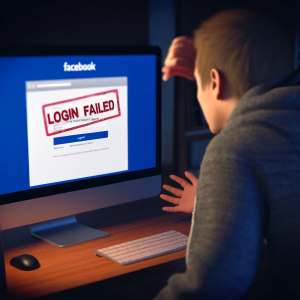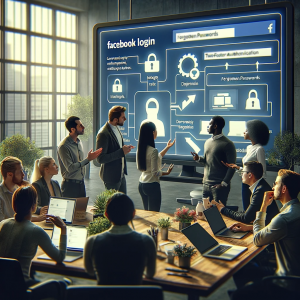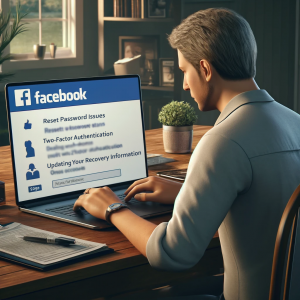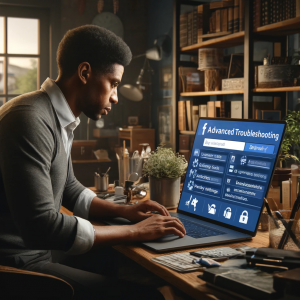Facebook Login Problems
Understanding the digital world can be challenging, especially when encountering Facebook login problems. Whether you’re trying to connect with friends, share updates, or manage a business page, being unable to access your account can disrupt your daily activities and communication. Common issues include forgotten passwords, error messages indicating wrong credentials, or system glitches that prevent you from logging in. These hurdles are not just minor inconveniences; they can lead to larger setbacks by cutting off access to essential social and business tools.
Understanding the root causes and solutions for why you can’t log in to Facebook is crucial. It ensures that you maintain uninterrupted access to your network and resources, which is vital in today’s interconnected world. Whether it’s for personal connection or professional use, every moment lost to troubleshooting could mean a missed opportunity or a breakdown in communication. This is why addressing Facebook login problems quickly and effectively becomes indispensable.
In this blog, we will explore a number scenarios that might prevent you from logging into your Facebook account, delve into why Facebook login problems occur, and provide practical solutions to get you back to your Facebook activities without significant downtime. By equipping yourself with this knowledge, you can minimize disruptions and maintain your important connections and business operations seamlessly.
Understanding Facebook Login Problems
Navigating the complexities of Facebook login problems requires an understanding of the most frequent issues users encounter. Recognizing these challenges is the first step toward regaining access to your account. Here, we will delve into the common obstacles that might prevent you from logging in, including forgotten passwords, account lockouts, two-factor authentication troubles, and perplexing error messages.
Common Facebook Login Problems
-
Forgotten Facebook Login Passwords
One of the most prevalent issues is forgetting your password. This is a common barrier that can impede access to your Facebook account, often leading to frustration. If you’ve tried various passwords and still can’t log in to Facebook, it’s likely you’re not remembering your most recent password update.

-
Facebook Account Locked or Disabled
Another significant issue arises when your account becomes locked or disabled. This can happen for a number of reasons such as suspected unauthorized access or violating Facebook’s community standards. If your account is disabled, you might see a message stating that your account has been locked for security reasons, leaving you unable to access your profile and wondering that why you can’t log in to Facebook.
-
Problems with Two-Factor Authentication for Facebook
Two-factor authentication enhances your account’s security but can also complicate the login process. If you have two-factor authentication enabled, you might find yourself unable to log in if you’ve lost your phone, can’t access the authentication code, or if the codes provided don’t seem to work. These Facebook login problems can make you feel helpless, especially if you urgently need access to your account.
-
Facebook Error Messages
Encountering error messages like “Incorrect Password” or “Account Not Found” can be particularly troubling. These messages often appear when there are typos in your login credentials or if there are issues with your account’s status. Such error messages are critical aspects of Facebook login problems as they provide clues about the underlying issues preventing access.
Understanding these Facebook login problems is crucial for resolving them effectively. Whether it’s resetting your password, recovering your account, or navigating through two-factor authentication, knowing the right steps to take can significantly reduce the stress and inconvenience associated with Facebook login problems.
Step-by-Step Solutions to Facebook Login Problems
Navigating through Facebook login problems requires a clear understanding of the recovery processes. This section provides detailed instructions to help you regain access to your Facebook account, whether your challenges lie in password recovery, two-factor authentication issues, or account lockouts.
Recovering Your Facebook Account
-
How to Reset Your Facebook Account Login Password
If you’ve forgotten your Facebook account login password, the first step is to reset it. For doing this, go to the Facebook login page and click on “Forgotten password?” Follow the prompts to enter your email or mobile number associated with your account. Facebook will then guide you through the steps to recover your account and set a new Facebook login password. This process is designed to log in to Facebook without much hassle.
-
What to Do if You Can’t Use Your Usual Recovery Methods
Sometimes, you may find that you can’t log in to Facebook because your usual recovery email or phone number is no longer accessible. In such cases, Facebook offers alternative methods to verify your identity. This might involve identifying friends in your uploaded photos or providing personal information that you had previously added to your profile. Always ensure to keep your recovery options up-to-date to avoid these complications.
Dealing with Two-Factor Authentication for Facebook
-
Steps to Regain Facebook Access When You’ve Lost Your Mobile Device
Losing access to your mobile device doesn’t have to mean losing access to your Facebook account. If you’re locked out of your account due to two-factor authentication issues and can’t access your usual device, you can use backup codes that were generated when you set up two-factor authentication. Store these codes in a safe place to ensure you can always regain access to your account if your device is lost.
-
Using Backup Codes for Logging in
If you have your backup codes at hand, simply enter one when asked for your two-factor authentication during the login process. Each code can only be used once, but you can generate new ones from your Facebook settings if you have access to your account.
Unblocking Your Facebook Account
-
How to Identify if Your Facebook Account is Locked or Disabled
If you’re facing an error that says your account is locked or disabled, it’s crucial to understand why. Typically, this happens when Facebook detects suspicious activity that violates its terms of service or when it thinks your account security might be compromised. You will get a message explaining the reason and what you can do next. If you face hacked issue with your account, read our detailed blog on Facebook Account Hacked.
-
Steps to Follow to Get Your Facebook Account Reactivated
To get your account reactivated, follow the Facebook instructions provided in the message you received. This often involves verifying your identity and reporting the Facebook login problems. Be prepared to provide any information that can help to verify your identity and ownership of the account.
Through this section, tackling Facebook sign in help topics such as resetting passwords, managing two-factor authentication, and recovering locked accounts becomes more manageable. Whether you’re dealing with an old Facebook login password or can’t access your account due to security features, these steps will assist you in resolving the Facebook login problems effectively and swiftly.
Best Practices to Prevent Facebook Login Problems
Securing your Facebook account effectively prevents common Facebook login problems and safeguards your personal data from unauthorized access. This section outlines essential preventative measures and highlights what not to do to avoid common security pitfalls and Facebook account login password issues.
Strengthening Your Facebook Account Security
-
Choosing a Strong Password
To mitigate Facebook login problems, choosing a strong, unique Facebook sign in password is crucial. Your password should be a complex combination of at least 12 characters, including capital letters and lowercase letters, numbers, and symbols. Don’t consider common passwords such as “123456” or “password,” and ensure you do not reuse passwords across different sites. A distinctive and complex Facebook sign in password is your primary defense against unauthorized access.
-
Enabling Two-Factor Authentication
Enhancing security to prevent Facebook login problems includes enabling two-factor authentication (2FA). This security feature adds a crucial layer of protection by requiring two forms of identification: your password and a code given to your phone or generated by an app. Activating 2FA drastically reduces the chances of unauthorized account access, safeguarding you against potential Facebook login problems.
-
Regularly Updating Your Recovery Information
To avoid Facebook login problems, keep your recovery information—such as your phone number, email, and trusted contacts—up to date. This practice is vital for regaining access to your account if you ever forget your Facebook sign in password or lose access to your primary email or phone. Updating this information regularly ensures that you have a fallback when needed to resolve Facebook login problems.
What not to do that lead to Facebook Login Problems
Knowing what to avoid is crucial in preventing Facebook login problems and enhancing account security. Key mistakes include:
-
Sharing your Facebook Sign In Password:
Never share your password, even with trusted friends or family. Keep your Facebook sign in password confidential to prevent Facebook login problems.
-
Clicking on suspicious links:
Avoid links that lead to unexpected offers or alarming claims. These are often phishing attempts designed to capture your Facebook sign in password.
-
Ignoring Software Updates:
Regular updates for your device and apps are crucial. Outdated software can cause vulnerabilities and increase the risk of Facebook login problems.
-
Using public WiFi without protection:
Accessing your account on public WiFi without a VPN can expose your Facebook sign in password to others on the network.
By adhering to these best practices and avoiding these common errors, you can significantly reduce the occurrence of Facebook login problems and keep your account secure.
Advanced Troubleshooting to Log In to Facebook
When simpler solutions don’t resolve your Facebook login problems, advanced troubleshooting steps can be vital. This section delves deeper into optimizing your browser and app settings, and understanding when and how to seek help directly from Facebook support to manage your Facebook login problems effectively.
Browser and App Considerations
-
Clearing Cache and Cookies
A common but often overlooked solution to Facebook login problems is clearing your browser’s cache and cookies. Over time, cached data and cookies can become corrupted, causing issues with loading and logging into sites like Facebook. Clearing these can reset session information and fix login errors, potentially resolving persisting Facebook login problems without further complications.
-
Updating the Facebook App and Your Browser
Keeping your software up-to-date is crucial in preventing and solving Facebook login problems. Updates generally include bug fixes and enhancements that improve security and functionality. Regularly updating your Facebook app and web browser ensures that you are using the most reliable and secure versions, reducing the likelihood of login issues and enhancing overall performance.
-
Situations Where Technical Support is Necessary
There are circumstances where Facebook login problems might require direct intervention from Facebook’s technical support team. If you’ve exhausted all standard troubleshooting methods without success, or if you suspect your account has been compromised, it’s essential to contact Facebook Support.
Navigating through advanced troubleshooting strategies and knowing when to seek help are critical in managing more complex Facebook login problems.
FAQs
Q1. What should I do if I forget my Facebook Account Login password?
- A. If you forget your Facebook account login password, you can change it by visiting the Facebook login page, clicking on “Forgotten password?”, and following the prompts. This will allow you to set a new Facebook login password and regain access to your account.
Q2. How can I resolve Facebook Login Issues if I can’t log in to my Facebook account?
- A. If you can’t log in to Facebook account, check if you are typing the correct Facebook login username and password. If the issue persists, use the Facebook Help Center for troubleshooting login problems, which might include resetting your password or resolving security alerts.
Q3. Why is my Facebook Account Locked, and how can I regain access?
- A. Your Facebook account may be locked due to unusual activity or a violation of Facebook’s policies. To regain access, follow the recovery options provided by Facebook, which may include verifying your identity or changing your Facebook sign in password.
Q4. What steps should I take if I can’t log in with my old Facebook Login Password?
- A. If your old Facebook login password doesn’t work, try resetting it. If you believe your account has been compromised, report the Facebook login issue through the official Facebook Help Center to secure your account and set a new Facebook login password.
Q5. How do I use the Facebook Login Code Generator if I can’t access my mobile device?
- A. If you cannot access your mobile device, you can use one of your saved backup codes to log in. To prepare for such situations, it’s advised to note down these codes from the Facebook login code generator when you set up two-factor authentication.
Q6. What is a Login Code for Facebook, and where can I find it?
- A. A login code for Facebook is a part of the two-factor authentication process, which adds an extra layer of security. You can receive this code via SMS, or generate it through an authentication app or the Facebook login code generator. If you can’t find or receive your code, check the 2FA settings on your Facebook account or contact support for Facebook help with login.
Q7. How do I update my Facebook Sign In password and username?
- A. To update your Facebook sign in password and username, go to your account settings, select security and login, and you can change your credentials there. Make sure to choose a strong password to enhance account security.
Q8. What should I do if I Can’t Log In on Facebook and receive an error message?
- A. If you receive an error message while trying to log in, this indicates a Facebook login issue. Verify your credentials and ensure there are no typos. Clearing your browser’s cache or updating the Facebook app may also resolve the issue.
Q9. What are the best practices for maintaining my account security to avoid future Facebook Login Problems?
- A. To maintain robust security and prevent future Facebook login problems, regularly update your Facebook login username and password, enable two-factor authentication, and keep your recovery information current. Avoid sharing your credentials and stay vigilant for any suspicious activity on your account.
Conclusion
Throughout this blog, we’ve delved into the common and complex aspects of Facebook login problems, providing you with a detailed roadmap to resolve these issues. From resetting your Facebook account login password to handling account lockouts and two-factor authentication challenges, we’ve covered essential strategies to ensure seamless access to your account. We emphasized the importance of adopting robust security measures like choosing strong passwords, regularly updating your recovery information, and enabling two-factor authentication to prevent future login issues.
I encourage you to consistently apply these best practices for maintaining the security of your Facebook account. By being proactive about your account settings and staying alert to new security features, you can significantly diminish the frequency of Facebook login problems and enhance your overall experience on the platform. For further assistance and more in-depth resources on Facebook troubleshooting login, the Facebook Help Center remains a valuable tool for ongoing support and Facebook help with login. Staying informed and prepared is your best defense against potential security threats and login challenges.


Melissa jones
I recently updated my Facebook account login password but I still can’t log in to my Facebook account. What additional steps can I take to troubleshoot this persistent issue?
Support Admin
If you have updated your Facebook account login password but still find yourself unable to log in to your Facebook account, there are a few more troubleshooting steps you can take. Firstly, ensure that no typos are made when entering your new Facebook login password and check that caps lock is not inadvertently enabled. If you are using a browser, try logging in from a different browser or device to rule out browser-specific issues. Additionally, clear your browser’s cache and cookies to remove stored data that may interfere with the login process. If these steps don’t resolve the issue, consider whether there might be a temporary server problem at Facebook, and try logging in again after some time. If none of these steps work, reaching out to Facebook help with login through their official support channels can provide you with more personalized assistance.
Amanda adams
I’m not receiving any authentication codes from the Facebook login code generator, and I can’t log in on Facebook. What should I do next to regain access to my account?
Support Admin
If the Facebook login code generator is not sending authentication codes, and as a result, you can’t log in on Facebook, the first step is to ensure your mobile device is connected to the internet and capable of receiving notifications. If you’re using an authentication app, make sure it is updated to the latest version. If you still do not receive codes, try restarting your device to resolve any temporary issues. If you have previously set up backup codes, use one of these codes to log in. Backup codes are crucial for situations where your primary two-factor authentication method fails. If all else fails and you still can’t log in on Facebook, you may need to contact Facebook help with login for further assistance in restoring access to your account.